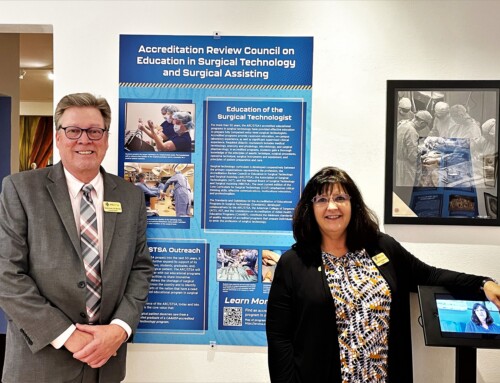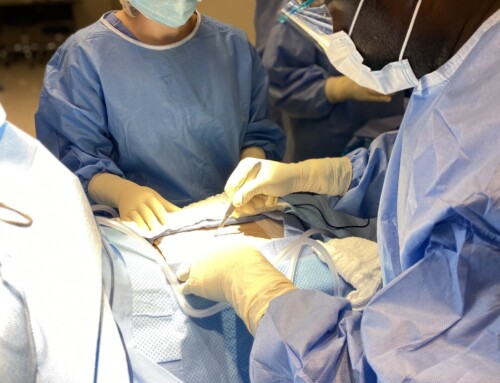By Chris Ahearn, AAS, CST
The June ARC/STSA newsletter highlighted ways that the surgical technology community might help to solve some difficult scenarios encountered when considering surgery in space. But surgical technologists’ out-of-this-world skills also have applications a little closer to home – the past years have brought a surge of growth to the telemedicine, telesurgery, and robotics fields.
Telemedicine can be defined as any technology or technique that uses telecommunications or any form of remote interactions for medical interventions; it is the virtual conveyance of healthcare related information between two distinct sites. Telemedicine encompasses several sub-categories that include telementoring and telesurgery. Telementoring entails remote guidance by an experienced expert mentor, i.e. a surgeon to a trainee, while telesurgery is the independent conduction of surgery by a remote surgeon via a robotic system such as the da Vinci. [1]
In this series conclusion, we will count down the inspiring events and highlights in surgical and robotics research that have shown that while there are significant challenges to surgery in space, the consensus is that it is feasible, and all the more so with the help of surgical technologists. After all, as Dr. Josef Schmid, Flight Surgeon and Orion Team Leader at NASA, said in Part I, “Surgical Technologists are a practical bunch who spend their careers in difficult situations, solving difficult problems.”
Let the countdown begin!
10… In 1967, Russian cosmonauts successfully perform surgery on rabbits during parabolic flights. Microgravity environments are achieved, and simple procedures like laparotomy and celiotomy are performed. [2]
9… Two years later during further parabolic flights, Russian cosmonauts show they can perform a more difficult procedure, successfully re-anastomosing a severed animal tail. [3]
8… Dr. Yulun Wang founds medical robotics company Computer Motion in 1990 with the goal of creating an endoscopic holder. With initial funding from NASA’s Jet Propulsion Laboratory Small Business Innovation Research grant, Computer Motion develops the Automated Endoscopic System for Optimal Positioning (AESOP) in 1993, the first surgical robot to receive FDA clearance. AESOP used voice-controlled commands to provide hands-free positioning of the laparoscopic camera system. [4]
While there were several surgical robots developed prior to the 1990s, the dominant driving force for the development of active robotic systems was the urgent necessity of telepresence. The U.S. military researched telepresence and telesurgery to potentially reduce mortality and morbidity of the military personnel in areas of conflict. Many of the researchers who created AESOP were initially involved in the initial military projects researching telesurgery and telepresence. [5]
7… One of the earliest uses of telementoring occurs in 1995 when an experienced surgeon mentors a trainee, 1,000 feet apart, to perform 23 laparoscopic procedures by utilizing high resolution video feeds, 2-way audio connections, and the AESOP robot. [1]
6… The first robotic-assisted laparoscopic cholecystectomy is performed March 3, 1997. The patient is 10 yards away from her surgeons.
Intuitive Surgical, maker of the da Vinci, is formed in 1995, and in 1997 moves their first robotic surgical system, Mona, to human trials. Dr. Jacques Himpens, a bariatric surgeon out of Saint-Blasium General Hospital in Dendermonde, Belgium, performs the cholecystectomy using Mona on a 72-year-old woman, maneuvering robotic instruments through two 10-mm ports with an endoscope connected to a third. Bedside assistance was offered by Dr. Guido Leman, who, as Mona lacked a camera-holding arm, held the endoscope for the duration of the procedure. [4]
5… In 2001, the first transatlantic robotic telesurgery is performed using the ZEUS, the first complete robotic surgery system. Surgeons in New York City operate on a 68-year-old female with a history of cholelithiasis. The patient and her soon to be removed gallbladder are in Strasbourg, France. [6]
In 1996, Computer Motion announced HERMES in collaboration with distributor Stryker Endoscopy. HERMES recognized and responded to surgeon’s programmed voice commands to engage or disengage arthroscopic or laparoscopic instruments during a procedure. Computer Motion quickly advanced into the first complete robotic surgery system, ZEUS, in 1996. ZEUS used the same software and platform as AESOP’s robotic arm but incorporated laparoscopic instrumentation. ZEUS prioritized improving laparoscopic surgery and the original intended use of surgical robotics as a remote surgery system.[4]
4… Project NEEMO (NASA Extreme Environment Mission Operation) Mission 7 is performed in 2004, establishing that telementoring is achievable in extreme environments. Four crew members, one surgeon, one MD with no surgical experience, and two aquanauts with zero medical training performed five test procedures. Ultrasound guided abscess drainage, repair of vascular injury, cystoscopy, stone extraction, and finally laparoscopic cholecystectomy were performed. [7]
Project NEEMO began in 2001 with the first of fourteen analog missions sending groups of astronauts, engineers and scientists to live in an undersea research station off the coast of Florida for up to three weeks at a time in preparation for future space exploration.
NEEMO has conducted three missions focusing on the applications of surgical robotics. The primary research focus of the NEEMO 7 mission was to evaluate telementoring and telerobotic surgery technologies as potential means to deliver medical care to astronauts during spaceflight. The NEEMO 7 crewmembers received minimal pre-mission training to perform selected medical and surgical procedures. [8]
3… The world’s first human operation is performed in a weightless environment in 2006. The cyst was successfully drained. [9]
2… In 2007, NASA scientists successfully perform robotic surgical knot tying in zero gravity. [9]
1… In 2010, NASA flight surgeons begin to focus on DCS, or damage control surgery. Catastrophic blood loss from stab injury, AAA, or intracranial hemorrhage are deemed most likely to occur in space. The use of topical hemostats and endovascular procedures to control bleeding are researched. [10]
Liftoff… NASA and the ESA are actively recruiting astronauts who can be cross trained to provide acute medical care during long-term space flights. NASA aims to launch a manned mission to Mars by the late 2030s or early 2040s.
“The flight time from Earth to Mars is 240 days. We are continuing to cross train our astronauts with the skills to perform life saving techniques in major hemorrhage intervention and infection control methods. Surgical techs can provide NASA with their expertise regarding necessary instrumentation and supplies needed to perform these tasks, should the need arise on a mission to Mars.”
– Dr. Josef Schmid
As space missions become longer in duration and take place further from Earth, enhancement of medical care capability and expertise will be required. The kinds of medical technologies demonstrated during the NEEMO 7 mission may play a significant role in enabling the human exploration of space beyond low earth orbit, particularly to destinations such as the Moon and Mars. [8]
The surgical technology community certainly has much to offer the NASA community as we strive to innovate and solve problems related to surgery in space.
Chris Ahearn, AAS, CST, served in the United States Air Force from 1978-1982 where he received his CST training. Ahearn worked for more than 30 years at the Level I Trauma Center -Stony Brook University Hospital on Long Island as a CST, clinical educator, ST program instructor, and finally, as program director at Suffolk County Community College, which received its initial accreditation in 2021. Ahearn serves as chair of the ARC/STSA’s Editorial Advisory Board where he is an active contributor.
Sources
- Ayoub, Christian Habib, et al. “Telemedicine and Telementoring in Urology: A Glimpse of the Past and a Leap into the Future.” Frontiers in Surgery, U.S. National Library of Medicine, 22 Feb. 2022, https://www.ncbi.nlm.nih.gov/pmc/articles/PMC8901873/.
- Haidegger, Tamás, and Zoltán Benyó. “Extreme Telesurgery.” IntechOpen, IntechOpen, 1 Jan. 2010, https://www.intechopen.com/chapters/6511.
- RD;, Campbell MR;Billica. “A Review of Microgravity Surgical Investigations.” Aviation, Space, and Environmental Medicine, U.S. National Library of Medicine, https://pubmed.ncbi.nlm.nih.gov/1520223/.
- George, Evalyn I, et al. “Origins of Robotic Surgery: From Skepticism to Standard of Care.” JSLS : Journal of the Society of Laparoendoscopic Surgeons, U.S. National Library of Medicine, 2018, https://www.ncbi.nlm.nih.gov/pmc/articles/PMC6261744/.
- Gupta, Amit, et al. “Training and Credentialing in Robotic Surgery in India: Current Perspectives.” Journal of Minimal Access Surgery, U.S. National Library of Medicine, 2022, https://www.ncbi.nlm.nih.gov/pmc/articles/PMC9632699/.
- Anvari, Mehran, et al. “Establishment of the World’s First Telerobotic Remote Surgical Service: For Provision of Advanced Laparoscopic Surgery in a Rural Community.” Annals of Surgery, U.S. National Library of Medicine, Mar. 2005, https://www.ncbi.nlm.nih.gov/pmc/articles/PMC1356984/.
- Todd, B. Reagan, M. “The NEEMO Project- A Report on How NASA uses the ‘Aquarius Undersea Habitat’ as an Analog for Long Duration Space Flight.”; 2003. Loff, Sarah “NEEMO – NASA Extreme Environment Mission Operations”. (Jun 24, 2015), https://www.nasa.gov/mission_pages/NEEMO/index.html
- Thirsk, Robert, et al. “NEEMO 7 Undersea Mission.” NASA/ADS, https://ui.adsabs.harvard.edu/abs/2007AcAau..60..512T/abstract.
- Rafiq A;Hummel R;Lavrentyev V;Derry W;Williams D;Merrell RC; “Microgravity Effects on Fine Motor Skills: Tying Surgical Knots during Parabolic Flight.” Aviation, Space, and Environmental Medicine, U.S. National Library of Medicine, https://pubmed.ncbi.nlm.nih.gov/16909881/.
- Pantalone, D, et al. “Facing Trauma and Surgical Emergency in Space: Hemorrhagic Shock.” Frontiers in Bioengineering and Biotechnology, U.S. National Library of Medicine, 1 July 2022, https://www.ncbi.nlm.nih.gov/pmc/articles/PMC9283715/.




